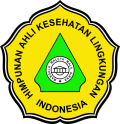EFEKTIVITAS VARIASI UMPAN PADA FLY TRAP DALAM PENGENDALIAN KEPADATAN LALAT
DOI:
https://doi.org/10.26630/rj.v15i1.2180Keywords:
Flytrap, flies, shrimp, fish gillAbstract
Flies are the main vector of gastrointestinal infections, so it must control them. Flytraps are one of the fly control methods that are considered the few risk to environmental health. This study aims to determine the effectiveness of flytraps decoy variations in chikens farm. The study used a completely randomized design (CRD), during February-April 2019. Two types of bait (shrimp and fish gills) were used from traditional market waste and placed in the flytrap (size 50cm x 50cm x 50cm). All trapped flies were counted using a tally counter two times (every 60 minutes). Experiments were carried out with five replication for each type of bait. The results showed that the total number of flies caught using fish gill bait was more (363) than shrimp (317). In the first 60 minutes, shrimp bait attracts as many as 22.8 flies (SD = 1.3) and 40.6 fish (SD = 3.6) in the second 60 minutes. Gill bait of fish attracted 25.4 individuals (SD = 0.9), and 47.2 individuals (SD = 2.6). The time variable shows the effect on the number of flies caught; it's related to decomposition time. The characteristics of fish gills high in water, protein, and blood are thought to cause interest in flies. The use of flytraps with fish gill bait is more effective than shrimp bait to apply it.Â
References
Acharya, N. (2015). House fly (Musca domestica L.) management in poultry production using fungal biopesticides. ProQuest Dissertations and Theses, (May), 185.
Adisasmito, W. (2007). Faktor Risiko Diare pada Bayi dan Balita di Indonesia. Jurnal Makara Kesehatan, 11(1), 1–10.
Agtini, M. D. (2011). Morbiditas dan Mortalitas Diare pada Balita di Indonesia Tahun 2000-2007. Ministry of Health, 2(2), 26–32.
Anisah, A., & Sukesi, T. W. (2018). Uji Efektifitas Ekstrak Daun Sirih (Piper betle L) sebagai Larvasida Larva Lalat Rumah (Musca domestica). Jurnal Vektor Penyakit, 12(1), 39–46. https://doi.org/10.22435/vektorp.v12i1.283
Attaullah, Zahoor, M. K., Zahoor, M. A., Mubarik, M. S., Rizvi, H., Majeed, H. N., … Qamer, S. (2020). Insecticidal, biological and biochemical response of Musca domestica (Diptera: Muscidae) to some indigenous weed plant extracts. Saudi Journal of Biological Sciences, 27(1), 106–116. https://doi.org/10.1016/j.sjbs.2019.05.009
Bhutta, Z. A., Das, J. K., Walker, N., Rizvi, A., Campbell, H., Rudan, I., & Black, R. E. (2013). Interventions to address deaths from childhood pneumonia and diarrhoea equitably: what works and at what cost? The Lancet, 381(9875), 1417–1429. https://doi.org/10.1016/S0140-6736(13)60648-0
Budiman, & Suyono. (2011). Ilmu kesehatan masyarakat : dalam konteks kesehatan lingkungan (M. Ester, Ed.). Jakarta: EGC.
Chavasse, D. C., Blumenthal, U., & Kolsky, P. (1994). Fly control in prevention of diarrhoeal disease. The Lancet, 344(8931), 1231. https://doi.org/10.1016/S0140-6736(94)90547-9
Das, J. K., Hadi, Y. B., Salam, R. A., Hoda, M., Lassi, Z. S., & Bhutta, Z. A. (2018). Fly control to prevent diarrhoea in children. Cochrane Database of Systematic Reviews, 2018(12). https://doi.org/10.1002/14651858.CD011654.pub2
Emerson, P. M., Lindsay, S. W., Walraven, G. EL, Faal, H., Bøgh, C., Lowe, K., & Bailey, R. L. (1999). Effect of fly control on trachoma and diar rhoea. The Lancet, 353(9162), 1401–1403. https://doi.org/10.1016/S0140-6736(98)09158-2
Fahrizal, A., & Ratna, R. (2018). Pemanfaatan Limbah Pelelangan Ikan Jembatan Puri Di Kota Sorong Sebagai Bahan Pembuatan Tepung Ikan. Gorontalo Fisheries Journal, 1(2), 10. https://doi.org/10.32662/.v1i2.421
Faumi, R., Akmal, Y., Zulfahmi, I., Almuslim, U., Almuslim, J., Dua, M. G., … Aceh, B. (2020). Perbandingan Secara Anatomi Insang Ikan Keureling ( Tor tambroides ), Ikan Mas ( Cyprinus carpio ) dan Ikan Nila , ( Oreochromis niloticus ). Jurnal Veteriner, 21(36), 234–246. https://doi.org/10.19087/jveteriner.2020.21.2.234
Fitri, A. (2020). Efektivitas Variasi Umpan Organik pada Eco-Friendly Fly Trap sebagai Upaya Penurunan Populasi Lalat di RPU Penggaron Kota Semarang. Universitas Negeri Semarang.
Fitriana, E., & Mulasari, S. A. (2021). Efektifitas Variasi Umpan Pada Fly Trap Dalam Pengendalian Kepadatan Lalat Di Tempat Pembuangan Sementara (TPS) Jalan Andong Yogyakarta. Jurnal Kesehatan Lingkungan Indonesia, 20(1), 59–64. https://doi.org/10.14710/jkli.20.1.59-64
Geden, C. J. (2012). Status of biopesticides for control of house flies. Journal of Biopesticides, 5(SUPPL.), 1–11.
Kaufman, P. E., Nunez, S. C., Geden, C. J., & Scharf, M. E. (2010). Selection for resistance to imidacloprid in the house fly (Diptera: Muscidae). Journal of Economic Entomology, 103(5). https://doi.org/doi: http://dx.doi.org/10.1603/EC10165
Klauck, V., Pazinato, R., Volpato, A., da Silva dos Santos, D., Santos, R. C. V., Baldissera, M. D., & da Silva, A. S. (2018). Insecticidal effect of several essential oils against Musca domestica. Comparative Clinical Pathology, 27(1), 167–172. https://doi.org/10.1007/s00580-017-2572-6
Krisdiyanta, & Ariyani, S. (2018). Kemampuan Jenis Umpan Lalat dengan Menggunakan Fly Trap di Tempat Pemrosesan Akhir ( TPA ) Sampah Talang Gulo Jambi. Jurnal Bahan Kesehatan Masyarakat, 2(1), 68–73.
Kusariana, N. (2013). Uji Resistensi Tiga Golongan Insektisida Terhadap Tiga Isolat Lalat Rumah Musca domestica (Diptera: Muscidae) di Bogor.
Leke, J. R., Widyastuti, T., Mandey, J. S., Najon, M., & Laihad, J. (2015). Penggunaan tepung insang cakalang (Katsuwonus pelamis) sebagai pengganti tepung ikan dalam beberapa level pemberian dan metode pengolahan terhadap performans ayam broiler. Seminar Nasional Masyarakat Biodeversity Indonesia, 1(4), 771–775. https://doi.org/10.13057/psnmbi/m010416
Ministry of Health Indonesia. (2019). Indonesia Health Profile 2019. In Ministry of Health Indonesia (Vol. 53).
Mosokuli, Y. S. (2001). Lalat Tungau dan Caplak sebagai vektor. Laboratorium Bioaktifvitas dab Biologi Molekuler FMIPA UNIMA.
Nadeak, E. S. M., Rwanda, T., & Iskandar, I. (2017). Efektifitas Variasi Umpan Dalam Penggunaan Fly Trap Di Tempat Pembuangan Akhir Ganet Kota Tanjungpinang. Jurnal Kesehatan Masyarakat Andalas, 10(1), 82. https://doi.org/10.24893/jkma.v10i1.167
Nelson, C. S., Beck, J. N., Wilson, K. A., Pilcher, E. R., Kapahi, P., & Brem, R. B. (2016). Obesity-related diseases are major contributors to morbidity and mortality in the developed world. Molecular diagnostics and targets of therapies to combat nutritional imbalance are urgently needed in the clinic. Invertebrate animals have been a cornersto. BMC Genomic, 17(1), 867.
Oktavia, D. A., Mangunwidjaja, D., Wibowo, S., & Sunarti, T. C. (2012). Pengolahan Limbah Cair Perikanan Menggunakan Konsorsium Mikroba Indegenous Proteolitik dan Lipolitik. Agrointek, 6(2), 65–71.
Onyenwe, E., Okore, O, O., Ubiaru, P. C., & Abel, C. (2016). Housefly-borne Helminth Parasites Of Mouauand Its Public Healt Implication For The University Community. Animal Research International, 13(1), 2352–2358.
Palus, T. S., Sanam, M. U. E., & Detha, A. I. R. (2016). Identifikasi Salmonella sp. dan Escherichia coli pada lalat di tempat penjualan daging Pasar Naikoten Kota Kupang. J. Veteriner Nusantara, 1(1), 10–13.
Pickering, A. J., Ercumen, A., Arnold, B. F., Kwong, L. H., Parvez, S. M., Alam, M., … Luby, S. P. (2018). Fecal Indicator Bacteria along Multiple Environmental Transmission Pathways (Water, Hands, Food, Soil, Flies) and Subsequent Child Diarrhea in Rural Bangladesh [Research-article]. Environmental Science & Technology, 52(14), 7928–7936. https://doi.org/10.1021/acs.est.8b00928
Putra, F. K. (2018). Efektifitas Atraktan Pada Fly Trap Terhadapjumlah Lalat Rumah (Musca Domestica). Jurnal Media Kesehatan, 6(2), 112–116. https://doi.org/10.33088/jmk.v6i2.200
Ristiati, N. P., Suryanti, I. A. P., & Indrawan, I. M. Y. (2018). Isolasi dan Karakterisasi Bakteri Tanah Pada Tempat Pemrosesan Akhir di Desa Bengkala Kabupaten Buleleng. Wahana Matematika Dan Sains, 12(1), 64–77. Retrieved from https://ejournal.undiksha.ac.id/index.php/JPM/article/view/pril2018-6
Saipin, Fadmi, F. R., & Mauliyana, A. (2019). Efektivitas Variasi Umpan terhadap Penggunaan Perangkap Lalat (Fly Trap) di Pasar Basah Anduonohu Kota Kendari. MIRACLE Journal of Public Health, 2(1), 112–120.
Sanyaolu, A., Okorie, C., Marinkovic, A., Jaferi, U., & Prakash, S. (2020). Global Epidemiology and Management of Acute Diarrhea in Children from Developing Countries. Ann Pediatr Child Health, 8(8), 1205.
Shane, S. M., Montrose, M. S., & Harrington, K. S. (1985). Transmission of Campylobacter jejuni by the Housefly (Musca domestica). Avian Diseases, 29(2), 384. https://doi.org/10.2307/1590499
Sucipto, D. C. (2011). Vektor Penyakit Tropis (1st ed.). Jakarta: Gosyen Publishing.
Suraini. (2013). Jenis-jenis Lalat(Diptera) dan Bakteri Enterobacteriaceae yang Terdapat di tempat Pembuangan Akhir Sampah (TPA). 53(9), 1689–1699.
Tanjung, N. (2016). Efektivitas Brbagai Bentuk Fly Trap dan Umpan Dalam Pengendalian Kepadatan Lalat Pada Pembuangan Sampah Jalan Budi Luhur Medan. Jurnal Ilmiah PANNMED, 11(3), 218–221.
Ugboko, H. U., Nwinyi, O. C., Oranusi, S. U., & Oyewale, J. O. (2020). Childhood diarrhoeal diseases in developing countries. Heliyon, 6(4), e03690. https://doi.org/10.1016/j.heliyon.2020.e03690
UNICEF. (2020). Diarrhoea. Retrieved from UNICEF website: https://data.unicef.org/topic/child-health/diarrhoeal-disease/
Wahyudi, P., Hadi, U. K., & Soviana, S. (2015). Keanekaragaman Jenis dan Prevalensi Lalat Pasar Tradisional di Kota Bogor. Jurnal Veteriner, 16(4), 474–482.
Walker, C. L. F., Rudan, I., Liu, L., Nair, H., Theodoratou, E., Bhutta, Z. A., … Black, R. E. (2013). Global burden of childhood pneumonia and diarrhoea. The Lancet, 381(9875), 1405–1416. https://doi.org/10.1016/S0140-6736(13)60222-6
Wang, L., Wei, B., Chen, Z., Deng, L., Song, L., Wang, S., … Zhang, Y. (2015). Effect of inoculum and sulfide type on simultaneous hydrogen sulfide removal from biogas and nitrogen removal from swine slurry and microbial mechanism. Applied Microbiology and Biotechnology, 99(24), 10793–10803. https://doi.org/10.1007/s00253-015-6916-3
Wateraid. (2019). Faeces, Fields, Fingers, Food, Fluids and Flies? Retrieved March 30, 2021, from Https://www.wateraid.org/ website: https://www.wateraid.org/au/articles/faeces-fields-fingers-food-fluids-and-flies
Yunianti Lapida. (2016). Uji Efektivitas Ekstrak Daun Sirih Hijau (Piper betle) sebagai Insektisida Alami Terhadap Mortalitas Walang Sangit (Leptocorisa acuta).
Yushananta, P., Ahyanti, M., & Hasan, A. (2018). Sanitasi Total Berbasis Masyarakat di Desa Muara Putih Kecamatan Natar Kabupaten Pesawaran. Sakai Sambayan Jurnal Pengabdian Kepada Masyarakat, 2(2), 76. https://doi.org/10.23960/jss.v2i2.79
Yushananta, P., & Usman, S. (2018). The Incidence of Diarrhea in Babies Affected through the Cleanliness of Eating Utensils and Hands. Journal of Medical Science And Clinical Research, 6(9). https://doi.org/10.18535/jmscr/v6i9.137
Downloads
Published
How to Cite
Issue
Section
License
Copyright (c) 2021 Ruwa Jurai: Jurnal Kesehatan Lingkungan

This work is licensed under a Creative Commons Attribution-NonCommercial 4.0 International License.

Ruwa Jurai: Jurnal Kesehatan Lingkungan is licensed under a Creative Commons Attribution-NonCommercial 4.0 International License.
Authors who publish with this journal agree to the following terms:
- Authors retain copyright and grant the journal right of first publication with the work simultaneously licensed under a Creative Commons Attribution-Non Commercial License that allows others to share the work with an acknowledgment of the work's authorship and initial publication in this journal.
- Authors are able to enter into separate, additional contractual arrangements for the non-exclusive distribution of the journal's published version of the work (e.g., post it to an institutional repository or publish it in a book), with an acknowledgment of its initial publication in this journal.
- Authors are permitted and encouraged to post their work online (e.g., in institutional repositories or on their website) prior to and during the submission process, as it can lead to productive exchanges, as well as earlier and greater citation of published work.









